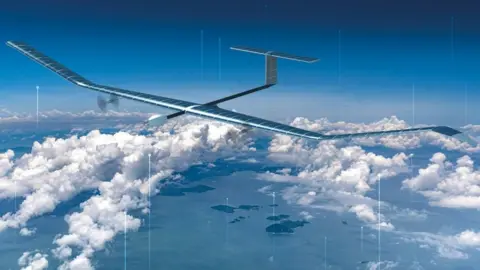Zephyr breaks own record for longest unmanned flight
 Airbus
AirbusAirbus has broken the record for the longest flight of an unmanned aircraft, flight-tracking data suggests.
The solar-powered Airbus Zephyr S has spent 26 continuous days airborne, beating the record it set in 2018.
The unmanned craft flies high in the atmosphere, to avoid commercial air traffic and adverse weather.
The aircraft has on-board batteries to keep it airborne overnight, meaning it does not need to stop to re-supply fuel.
Flight data shows the aircraft flew from the test range in Arizona to Belize in Central America, and then back again.
Airbus told the BBC it could not comment on the flight.
A spokesperson for the Assured Position, Navigation and Timing/Space office of the United States Army Futures Command - a branch of the US Army - told The Drive the latest flight tests are "intended to test the UAV's energy storage capacity, battery longevity, solar panel efficiency, and station-keeping abilities".
Tim Robinson, editor-in-chief of Aerospace magazine, told the BBC he thought this distance marked an important milestone for the aircraft's ability to travel beyond the line of sight of its operators.
"They've flown over the range from 2018 when it set the previous record," he said. "It's transmitted out to this area and beyond line-of-sight communications, and it's gone somewhere else.
"I think that's an important demonstration of how you would use it in reality."
He said this opened the door for practical uses of the aircraft, such as military applications or even disaster relief.
 Airbus
AirbusSatellite comparison
The aircraft can provide imagery like a satellite, but it does not have the limitation of having to orbit Earth - meaning it can remain in one position and provide constant updates.
But it has another key advantage over satellites, which generally cannot return to Earth after being launched.
"It comes back to you," said Mr Robinson. "You can upgrade sensors on it, you can switch the payloads out, you can upgrade it with a new technology."
The flight record was achieved by the latest model of the solar-powered aircraft, which was originally designed and built in the UK.
Zephyr was invented by Chris Kelleher, who died in 2015. Airbus opened the first serial production facilities for this type of aircraft in Farnborough three years later, and named them in his honour.
It remains airborne at the time of writing, and flight operators seemed to celebrate its 27th continuous day in the sky by referencing its heritage.
Operators used the aircraft's flight path to spell out "UK", along with what might kindly be called a rudimentary image of Stonehenge.
